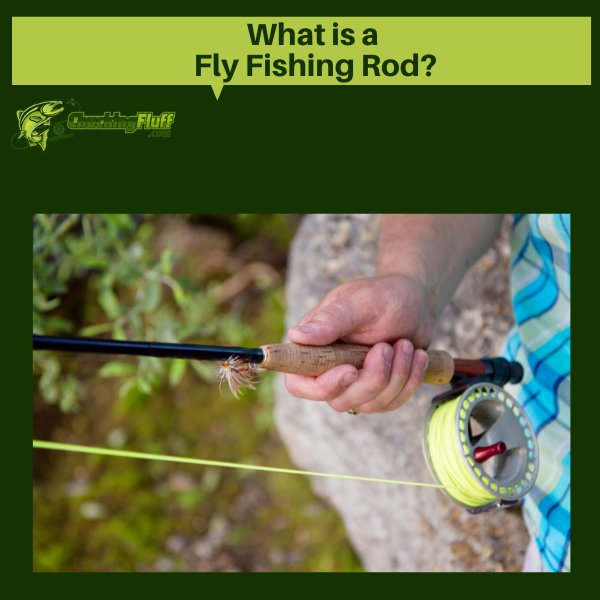| Disclosure: Just to be open and honest the buttons and links you click on in the website will in most cases take you to another website where you can purchase the products I am reviewing. As an Amazon Associate I earn from qualifying purchases. |
What is a Fly Fishing Rod?

Fly fishing rods are fishing poles specifically built for anglers who fish using flies; they are like any other fishing rod in most ways but also quite different.
Its broad manufacturing principle is similar to those of other fishing rods; however, some aspects and features make it unique to its fishing style, techniques and methods.
Can you use an ordinary fishing rod to fly fish?
I knew this would come up and thought to clarify it as early as now.
You can’t!
Fly fishing rods are typically extremely thin and lightweight compared to most rods.
Regardless of the material it is made of; it is a thin yet tapered tube.
There is so much technicality that goes into the manufacture of fly fishing rods to understand why they are built the way they are.
But a brand like Orvis that is generous enough to share its process gears everything towards ease of fishing, comfort and longer rod handling without fatigue.
The art of fly fishing is unique in its way; hence the tackle has to be lightweight to ensure you enjoy the act to the fullest without feeling overwhelmed by the weight of your gear – and a fly fishing rod is part of the tackle you need.
Quick Post Navigation
History of Fly Fishing Rods
Anglers in this era celebrate two millennia of fly fishing rod innovation and history even though the oldest records of these rods bore very little similarity to their contemporary kin.
The earliest reference to these rods dates back to Aelian’s Natural History, a book published by Aelian, a Roman angler, in 200AD.
The book illustrates a Macedonian angling technique using homemade hooks and red wool tied to wooden sticks.
Wooden rods in this era were heavy and stiff; weighing above 20 pounds, you can imagine the exhaustion after one short session.
The 17th and 18th centuries saw artisans hollowing fly rods to counter heavyweight.
Builders experimented with different wood types to make custom rods and create various fly rod tapers.
The Greenheart wood was the commonest, and Hardy was among the first manufacturers to embrace it in the 1950s.
The 18th century came with bamboo fly rods that gained popularity for their flexibility and lightweight composition.
Samuel Philippe, an American violin maker, built the first split cane fly rod and many builders developed new tapers and modified ferrules.
In the 19th century, the sport gained even more popularity, with companies like Montague, Hardy Brothers and South Bend gracing the period.
During this time, the split cane rod was still popular until the 20th-century fibreglass, and other resins struck the attention of most anglers.
Slowly, society began transitioning from fibreglass to modern-day rods made from graphite.
This doesn’t mean that the predecessors have been faced out.
Advancements in technology are seeing manufacturers modifying the old fly rods into a more stylish and functional tackle that you can’t imagine.
Understanding a Fly Rod
These poles are beasts and a handful of arcane-sounding terms that anglers, manufacturers, dealers and guides used to describe them.
Regular fishing rods (casting or spinning rods) use heavier lures to pull light lines to their target locations.
Fly rods do the contrary as heavy lines pull lighter flies to their desired targets.
I will break down the components of a simple fly rod to sink in better before I can round up another piece on how to use fly rods.
An Overall Look at the Fly Rod
A fly rod generally comprises various components – a blank, grip and a reel seat.
These three are the primary parts that make it what it is.
The blank is the shaft upon which other fly rod attachments and components are built.
Blanks come in different weights and lengths depending on the angling conditions you intend to use them in.
The grip is where an angler is connected to their fly rod, and there are several grip styles to cater to various fishing situations.
A reel seat is a threaded metallic cylinder and part of the fly rod connecting the reel to the rod.
At least, most fly rods can be disintegrated into two or more parts for easier storage and transportation.
You will hear or read about two-piece rods (2pc), four-piece rods (4pc) and the like.
This means a fly rod can be broken down into pieces to make it more compact.
The sections below briefly describe the individual parts of a fly rod, but there are detailed posts on most parts explaining their pros, cons and types (if any).
- Reel Seat – The part that holds the fly reel to the fly rod.
- Grip – Mostly made from cork, this part allows you to hold your rod in the correct way for the style of fishing or technique you need to execute.
- Hook Keeper – This is where you hook a fly when your fly rod is setup and ready to swing into action.
- Butt – It is the bottom third or half of the fly rod’s blank and holds the handle and reel seat.
- Guides – These are small ring-like attachments to the blank above the reel seat and are built to control your fishing line.
- Stripping Guide – It is the first guide your fly line passes through while coming off the reel usually coated with ceramic to prevent friction that can shorten an angler’s casting distance.
- Ferrule – A ferrule is like a male and female connection, just like how electric plugs are, but these join one part of the fly rod to the other.
- Snake Guides – Thin wire guides allow the fly line to run true and straight with the most minimal amount of friction.
- Tip – This is the last or so foot of the fly rod.
- Top Guide – A circular guide directing the fly line out into your space, and if your rod is well positioned, it points towards your catch.
Most fly rod handles are made from cork, an extremely lightweight material that blends and balances perfectly with fly fishing rods.
Cork creates a good surface offering friction of excellent contact without being uncomfortable to the angler’s hand.
The material gives the angler a touch on the fly rod that you can never experience with plastic or foam rubber grips of baitcasting or spinning rods.
Standard grips are the commonest, but others also exist; however, they are variations of different themes.
Below is a brief description of some of the common grip styles:
- Standard – A superb contoured feel that gives an angler gripping surface where they need it and curved sections where their hands fit snugly.
- Cigar – Such a pleasant grip with a hand-filling shape like the actual cigar is; the shape allows the angler to raise their forefinger for tighter loops in short and delicate casting situations.
- Full Wells – These have tapered fronts allowing you to raise your thumb easily to allow for more powerful casts with that extra punch. This grip is perfect for allowing for greater fighting force when dealing with bolting or monster fish.
A little about the fighting butt,
Most fly rod manufacturers offer fighting butts for six weight rods and above.
The butt allows an angler to jam the fly rod against their torso or along their forearm when fighting stronger fish.
These sections give the fisherman/woman more leverage.
This means if well prepared; you can subdue a monster salmon on a light fly rod; however, you will be less tired if your fly rod has a fighting butt.
The Reel
Digressing?
Not entirely since once you attach your reel to the rod, it becomes part of the setup, so talking a bit about this tackle will make sense though there are separate posts on it.
The primary purpose of your fly reel is to hold the fishing line being retrieved as you rotate the handle fitted on it.
As earlier said, the reel seat is where the reel is connected to the fly rod.
Most reels have a drag mechanism that controls the release speeds of the fly line from the reel.
High-quality reels resistant to rust and corrosion often last a lifetime if well-taken care of.
If yours fails, or needs a change, repurchase another online or from a tackle store.
It is crucial to ensure that the connection between the reel and the rod is very secure since many fish have bolted without giving anglers second chances because of the reel and rod separating during fights.
There is so much about fly fishing rods that we have discussed and are yet to write about on the website.
Check out fly rod buying guides, fly rod reviews and advice to learn more and how well you can use your fly rod.


